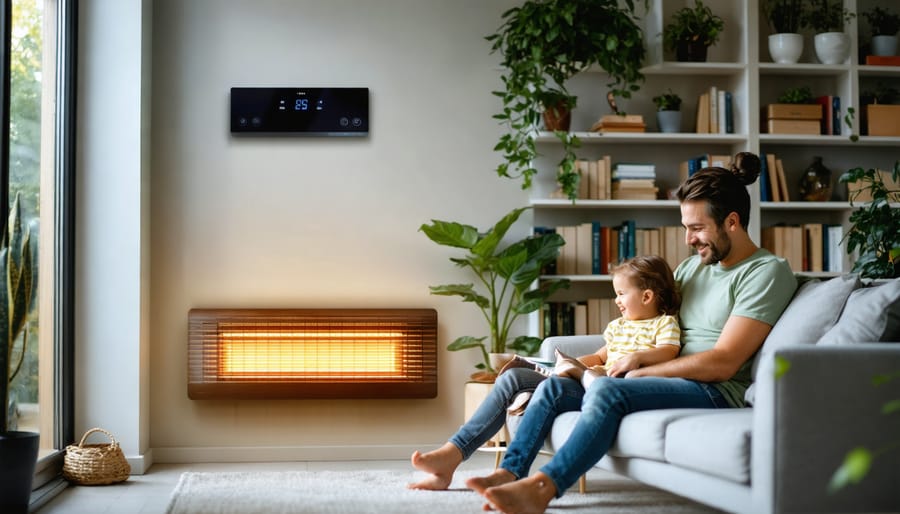Position your TV at eye level across from your main seating area, creating a natural focal point that anchors the entire room layout. Arrange furniture in conversational zones that bring people together rather than pushing everything against the walls—this transforms an overwhelming open space into an inviting gathering spot. Place your sofa 8-12 feet from the screen for optimal viewing comfort, then flank it with accent chairs angled slightly inward to encourage conversation while maintaining clear sightlines to both the television and your fireplace.
Balance your TV placement with your fireplace by treating them as complementary features rather than competing elements. Mount the television on an adjacent wall to create an L-shaped entertainment zone, or position it above a low console opposite the fireplace to establish two distinct areas for relaxation and warmth. This approach honors both the practical need for entertainment and the atmospheric comfort that a crackling fire brings to your home.
Layer area rugs to define separate zones within your expansive space—a media viewing area, a reading nook near the fireplace, and perhaps a game table section. These visual boundaries help decorating large living rooms feel more intimate and purposeful. Add floor lamps and side tables at conversation distance to create multiple points of light and function throughout the room, preventing that cavernous feeling while maintaining the generous, breathable atmosphere that makes large spaces so appealing.
The Fireplace-TV Dilemma: Why Large Rooms Need a Different Approach
In smaller living rooms, the solution often seems straightforward: mount the TV above the fireplace and call it a day. But if you’ve tried this approach in a spacious living room, you’ve likely discovered the problem—viewing angles become awkward, the screen feels too high, and suddenly your cozy gathering space feels more like a neck-strain nightmare.
Here’s the thing about large living rooms: they actually present an opportunity rather than a limitation. While compact spaces force you to stack your focal points or choose between them, generous square footage gives you the breathing room to honor both your fireplace and your TV without compromise. Think of it as having two stars in your room instead of forcing one into a supporting role.
The traditional fireplace-versus-TV tension stems from both elements naturally commanding attention. Your fireplace brings that irreplaceable warmth and ambiance—it’s a lifestyle element that draws people together for conversation and relaxation. Meanwhile, your TV serves a different but equally important purpose for entertainment and family time. In cramped quarters, these two compete for wall space and sightlines. But in a large living room, you can embrace large room design strategies that celebrate both.
The secret lies in understanding that spacious rooms allow for multiple seating arrangements and viewing zones. You’re not limited to one sofa facing one wall. Instead, you can create distinct conversation areas, angle furniture thoughtfully, or even establish separate zones where your fireplace anchors one gathering spot while your TV defines another. This flexibility transforms what seems like a design challenge into an exciting opportunity to craft a truly functional, multi-purpose space that serves your entire household’s needs—whether that’s curling up by the fire with a book or hosting movie night with the family.
Three Proven Layout Strategies That Honor Both Your Fireplace and TV
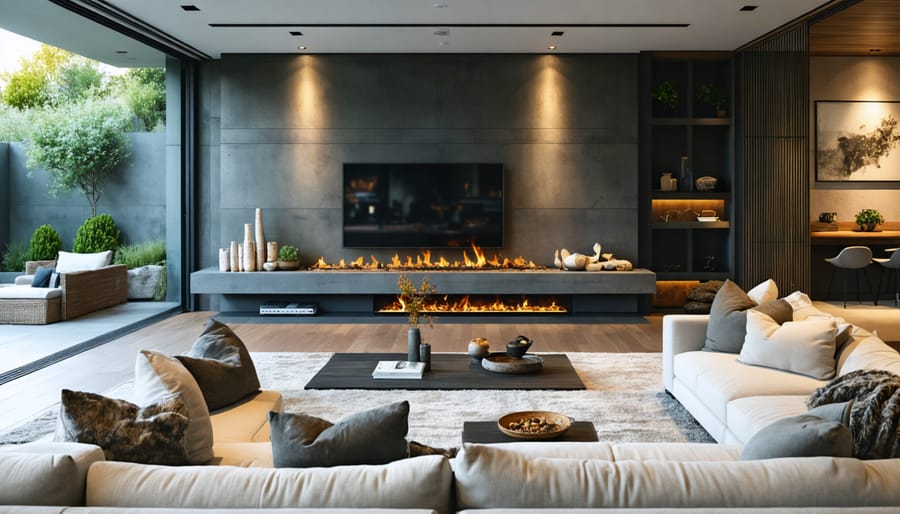
The Side-by-Side Layout: When Your Wall Space Is Your Best Friend
When you’re blessed with a generous expanse of wall in your large living room, placing both your TV and fireplace side by side creates a stunning focal point that actually simplifies your layout puzzle. This arrangement works beautifully because it concentrates your room’s two main attractions in one viewing zone, making furniture placement more intuitive and creating a natural gathering spot for the whole family.
The key to making this layout shine is getting the spacing right. Ideally, you’ll want at least 18 to 24 inches of wall space between your fireplace and TV. This breathing room prevents visual crowding and gives each element its moment to shine. If your fireplace generates significant heat, this spacing also protects your television from potential damage—a practical consideration that keeps your investment safe while maintaining that cozy ambiance we all love.
When arranging your furniture, think symmetry and balance. Position your main seating—whether that’s a sectional or sofa—directly across from this feature wall, ensuring everyone has comfortable sightlines to both the flickering flames and their favorite shows. Adding side chairs or a loveseat perpendicular to the sofa creates an inviting conversation area while filling your spacious room without overcrowding.
Here’s where visual weight comes into play. If your fireplace is large and ornate, consider mounting your TV on the sleeker side to balance the composition. A low-profile entertainment console beneath or beside the TV can help ground the arrangement. Conversely, if you have a minimalist modern fireplace, you might opt for a more substantial TV setup or add artwork and décor to create equilibrium.
Don’t forget that your fireplace brings warmth to more than just the temperature—it’s a lifestyle element that makes your living room the heart of your home. During warmer months when the fireplace isn’t in use, you can style the hearth with candles, plants, or decorative logs to maintain its visual appeal while the TV takes center stage for movie nights.
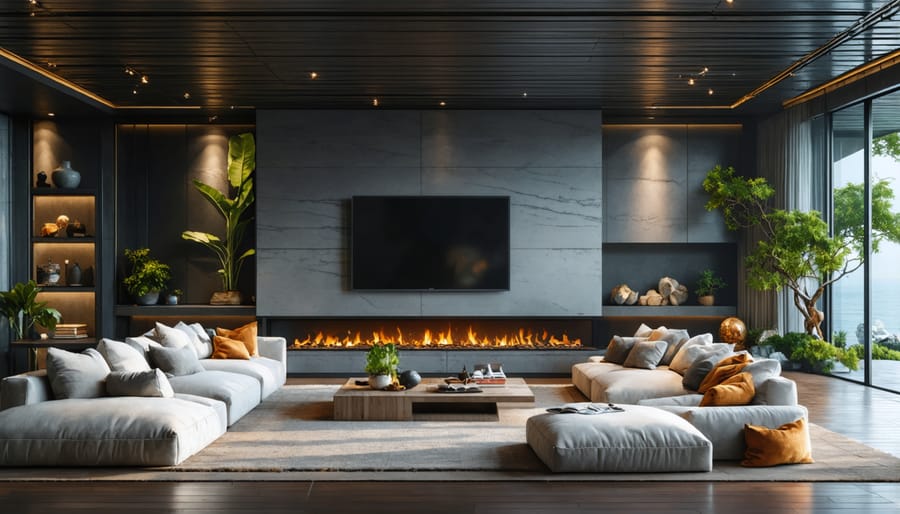
The Perpendicular Layout: Creating Two Distinct Living Zones
When you have both a television and fireplace competing for attention in your large living room, the perpendicular layout offers an elegant solution that honors both elements. By positioning these focal points on adjacent walls, you create two distinct zones that work harmoniously together rather than fighting for dominance.
This arrangement naturally divides your spacious room into a cozy conversation area centered around the fireplace and a dedicated entertainment zone facing the TV. Think of it as creating two complementary living experiences within one room—perfect for households where some family members want to enjoy the crackling warmth of the fire while others catch up on their favorite shows.
To make this layout work beautifully, start by anchoring your main seating—typically a sofa—in the corner where both focal points meet. Position it at an angle if space allows, creating a natural pivot point between the two zones. This strategic placement means you can easily swivel to enjoy either the mesmerizing dance of flames or movie night without awkward neck-craning.
Add comfortable chairs or a loveseat facing the fireplace to complete your conversation zone, keeping the seating close enough for intimate discussions. A plush area rug helps define this cozy gathering spot while adding warmth underfoot during chilly evenings—embracing that eco-friendly heating your fireplace provides.
For the entertainment zone, arrange additional seating perpendicular to the TV wall, ensuring clear sightlines and comfortable viewing angles. Leave at least three feet of clearance between furniture pieces to maintain smooth traffic flow—crucial in larger spaces where people need to move freely between zones.
Consider the natural pathways people will take through your room. Avoid blocking the connection between your two zones, as this layout’s beauty lies in its flexibility. Family and friends should flow seamlessly from fireside chats to shared entertainment, making your large living room feel purposeful and inviting rather than cavernous.
The Opposite Walls Layout: Maximum Flexibility for Entertaining
When you’re blessed with a spacious living room, placing your TV on one wall and your fireplace on the opposite wall opens up a world of entertaining possibilities. This layout transforms your space into what I like to call a “social butterfly” room—flexible enough to adapt to any gathering, from movie marathons to cozy fireside conversations.
The beauty of this arrangement lies in its natural division of purpose. Your fireplace wall becomes the heart of intimate gatherings, perfect for those chilly evenings when you want everyone huddled around the warmth with mugs of hot cocoa. Meanwhile, your TV wall serves as entertainment central for game days and family movie nights. Think of them as two distinct experiences living harmoniously in one space.
Here’s where smart furniture placement makes all the difference. Position a large sectional or sofa perpendicular to both focal points, allowing clear sight lines to each feature. Add a swivel chair or two—these are absolute game-changers for flexibility. Guests can pivot toward the TV for the big game, then swing around to face the fireplace for after-dinner conversation. It’s like having two living rooms in one.
Consider creating a floating furniture arrangement in the center of the room rather than pushing everything against the walls. This approach makes your large space feel intentional and intimate while maintaining access to both features. A substantial area rug anchors the seating area and defines the social zone.
Lighting plays a crucial role too. Install dimmers near both focal points so you can set the mood appropriately—brighter for TV viewing, softer and more ambient when the fireplace takes center stage. This flexibility extends to your heating strategy as well; your fireplace becomes an eco-friendly heating solution that reduces reliance on central heating while adding undeniable ambiance.
The key is remembering that neither feature needs to dominate constantly. This layout celebrates both equally, giving you the freedom to highlight whichever element suits the moment best.
Furniture Placement That Makes Your Room Feel Cozy, Not Cavernous
The biggest mistake people make with large living rooms? Pushing all their furniture against the walls like they’re clearing space for a dance floor. Sure, it maximizes floor space, but it also makes your room feel like a hotel lobby instead of a cozy retreat where you actually want to spend time.
Here’s the secret: **float your furniture away from the walls**. Pull your sofa 12-18 inches into the room to create an anchor point. This single move transforms everything—suddenly, you’re not rattling around in a cavernous space, but sitting in a defined, intimate area that still feels spacious.
**Creating conversation zones** is your next priority, especially when you’re working with both a TV and a fireplace (lucky you!). Instead of cramming all your furniture into one massive arrangement, break the room into distinct areas. Position your main seating—a sofa and two chairs, perhaps—to face the TV at a comfortable viewing angle, typically 8-10 feet away depending on screen size. Then, create a secondary seating area near the fireplace with a loveseat or pair of accent chairs flanking it. This setup lets different people enjoy different focal points simultaneously, making your large room actually functional rather than just impressive.
Consider your flooring choices when defining these zones, too—area rugs are your best friend for visually anchoring furniture groupings and adding warmth underfoot. A large rug under your main seating area (big enough that at least the front legs of all furniture pieces sit on it) signals “this is the cozy spot.”
**Don’t forget the power of strategic placement**. A console table behind your floating sofa creates a natural boundary and provides display space. Bookshelves or a tall plant can act as a room divider without blocking sightlines. Side tables should always be within arm’s reach of seating—nobody wants to lunge for their coffee.
The goal isn’t to fill every square foot, but to create pockets of comfort that draw people in. Your fireplace naturally creates warmth and ambiance, so let it work its magic on one zone while your TV entertains in another. This layered approach means your large living room serves multiple purposes without feeling empty or overwhelming—just welcoming and lived-in.
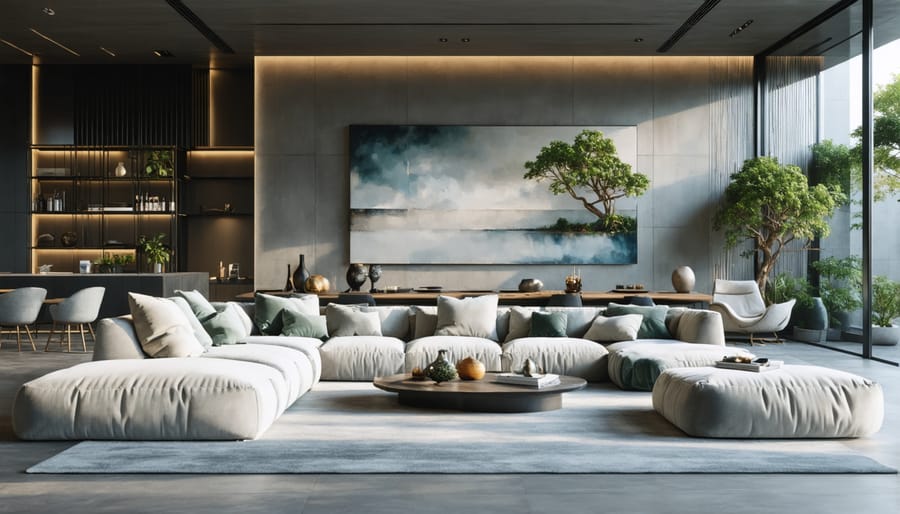
The Viewing Angle Problem (And How to Fix It)
Let’s talk about something that affects every large living room—making sure everyone can actually enjoy what they’re watching without craning their necks or squinting from across the room. When you’re working with generous square footage and multiple focal points like a fireplace, getting the viewing angles right becomes even more important.
The golden rule for TV viewing distance is simple: multiply your screen size (measured diagonally) by 1.5 to 2.5. So if you have a 65-inch TV, you’ll want your primary seating between 8 and 13 feet away. In large rooms, this often means creating a more intimate seating zone within the larger space rather than pushing furniture against the walls.
Eye-level mounting is crucial for comfort. When seated, your eyes should align with the center of the screen or slightly below. If your TV sits above a fireplace mantel, consider a tilting mount that angles the screen down toward viewers—this prevents that uncomfortable upward gaze during movie marathons. Ideally, the bottom of your TV should be no more than 42 inches from the floor.
Here’s where it gets interesting with dual focal points: arrange your main seating in a gentle arc or angled configuration that faces both the TV and fireplace. This lets people naturally pivot between conversations around the hearth and screen time without repositioning furniture. Swivel chairs and sectionals with chaise ends work beautifully for this flexible viewing.
For secondary seating areas in your large room, don’t stress about perfect TV sightlines—these spots become your cozy reading nooks or intimate conversation areas where the fireplace takes center stage, creating that layered, lived-in warmth every home deserves.
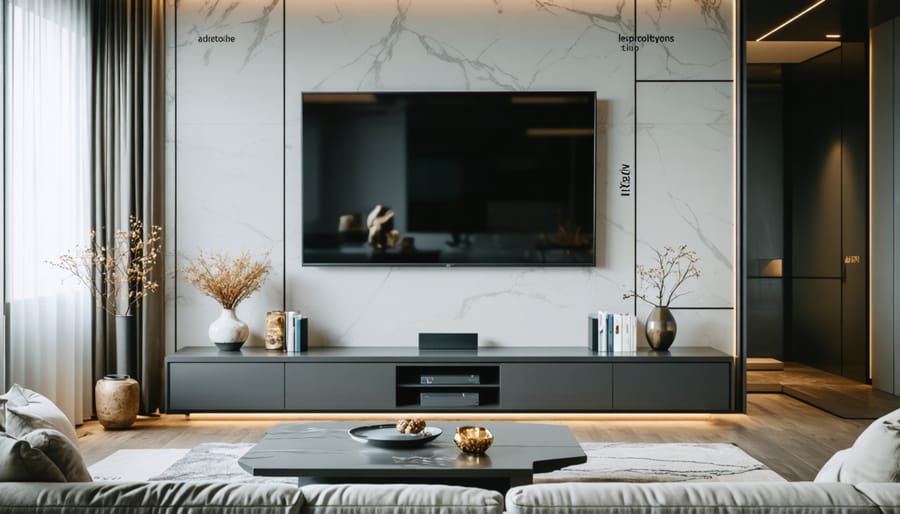
Using Your Fireplace to Anchor the Room’s Warmth and Ambiance
Your fireplace doesn’t have to compete with your TV—instead, think of them as design partners that work together to create the ultimate relaxation zone. The key is positioning these focal points so they complement rather than clash with each other.
When it comes to fireplace types for TV-friendly layouts, modern options offer incredible flexibility. Electric fireplaces are particularly versatile since they don’t require venting, allowing you to mount them directly beneath your TV or integrate them into a media console. Gas fireplaces provide authentic flames with minimal maintenance, perfect for those movie marathons when you want real fire ambiance without constantly tending to logs. Bioethanol fireplaces offer an eco-friendly heating solution that’s portable and doesn’t require a chimney, making them ideal for creating secondary warmth zones in your large living room.
The magic happens when you use your fireplace to enhance the viewing experience. Position seating to enjoy both the screen and the dancing flames—an L-shaped sectional works beautifully for this dual-focus arrangement. During movie nights, dimming the lights and letting the fireplace glow creates an immersive, theater-like atmosphere that makes every film feel special.
Consider installing your fireplace and TV on the same wall to create a unified entertainment focal point. This arrangement keeps eyes forward and makes furniture placement straightforward. Alternatively, placing them on perpendicular walls allows you to rotate seating depending on whether it’s movie time or cozy conversation hour.
The result? A warm and inviting atmosphere where technology and tradition blend seamlessly. Your fireplace becomes more than a heat source—it’s the element that transforms ordinary evenings into memorable experiences, wrapping your entertainment space in comfort and style.
Common Large Living Room Layout Mistakes to Avoid
Even the most beautifully spacious living room can feel awkward if you make these common layout mistakes. Let’s walk through the pitfalls we see most often—and how to fix them quickly.
**Mounting the TV Too High Above the Fireplace**
We get it—the fireplace is your room’s natural focal point, and it seems logical to place the TV above it. But mounting your screen too high creates neck strain and diminishes your viewing experience. The center of your TV should be at eye level when seated, typically around 42 inches from the floor. If your fireplace mantel sits higher than this, consider placing your TV on a nearby wall instead, creating two distinct zones. This arrangement actually honors both features rather than forcing them to compete. You’ll enjoy cozy fires without craning your neck during movie night.
**Pushing All Furniture Against the Walls**
In large rooms, lining furniture along the perimeter creates a bowling alley effect with an uncomfortable void in the center. Instead, float your seating arrangement closer together, anchoring it with an area rug. This creates an intimate conversation zone while making your space feel purposefully designed rather than empty.
**Ignoring Traffic Flow**
Dead-end pathways and blocked walkways frustrate daily living. Leave at least 30 inches for major traffic routes through your room, and ensure people can move from doorways to seating areas without climbing over furniture. Think of your layout as creating natural circulation patterns that guide movement smoothly.
**Blocking Natural Light**
Don’t place tall furniture or your TV directly in front of windows. Natural light enhances your room’s warmth and reduces energy costs—an eco-friendly bonus. Position seating to enjoy window views while keeping your screen perpendicular to light sources to minimize glare.
**Creating Unusable Dead Space**
Those awkward corners behind doors or beside the fireplace? Transform them into reading nooks with a comfortable chair and floor lamp, adding both function and cozy ambiance to forgotten areas.
Your large living room isn’t a challenge to overcome—it’s an incredible opportunity to create a space that truly reflects how you live. With thoughtful planning, you can absolutely have both an entertainment-friendly TV setup and a warm, inviting fireplace that serves as your home’s heart. The key is embracing the possibilities your generous square footage offers rather than feeling overwhelmed by it.
Don’t be afraid to experiment with different arrangements until you find what works best for your family’s daily routines. Move furniture around, try various viewing angles, and pay attention to how the space feels during different times of day. Remember that creating cozy spaces within larger rooms is all about intentional placement and understanding how people naturally gather.
As you finalize your layout, keep safety top of mind—maintain proper clearances around your fireplace, ensure adequate ventilation for gas or wood-burning units, and consider eco-friendly options like electric fireplaces that offer ambiance without emissions. If you’re unsure about technical aspects like mounting a TV above a fireplace or installing new heating elements, consulting with professionals ensures both safety and optimal performance.
Your living room should serve your lifestyle while embracing the warmth and comfort that makes a house truly feel like home. With these strategies in hand, you’re ready to create a space that works beautifully for movie nights, quiet evenings by the fire, and everything in between.


